What'sNEW Archives, May-June 2006
 29 June 2006 29 June 2006
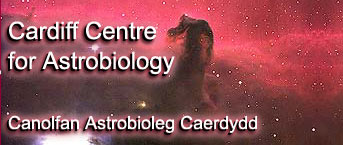 Conference on Cosmic Dust and Panspermia — Chandra Wickramasinghe and Fred Hoyle have been pioneers of the modern version of cometary panspermia. From being a fringe theory derided 30 years ago, panspermia is fast gaining acceptance in mainstream astrobiology. The conference to mark the completion of Chandra's 33 year long tenure of a professorship in Cardiff aims to bring together research workers in diverse areas of science that appear to have a bearing on unravelling our cosmic ancestry, and in one way or another supports the concept of panspermia. The venue of the conference at a leading UK university in an attractive city which is Europe's youngest capital city is an added bonus to prospective participants. Since the number of places is limited, early registration is recommended.
Conference on Cosmic Dust and Panspermia — Chandra Wickramasinghe and Fred Hoyle have been pioneers of the modern version of cometary panspermia. From being a fringe theory derided 30 years ago, panspermia is fast gaining acceptance in mainstream astrobiology. The conference to mark the completion of Chandra's 33 year long tenure of a professorship in Cardiff aims to bring together research workers in diverse areas of science that appear to have a bearing on unravelling our cosmic ancestry, and in one way or another supports the concept of panspermia. The venue of the conference at a leading UK university in an attractive city which is Europe's youngest capital city is an added bonus to prospective participants. Since the number of places is limited, early registration is recommended.
 Cosmic Dust and Panspermia, Conference at Cardiff University, Cardiff UK from 5-8 September 2006. Cosmic Dust and Panspermia, Conference at Cardiff University, Cardiff UK from 5-8 September 2006.
 Chandra Wickramasinghe contains a 1981 writing about panspermia. Chandra Wickramasinghe contains a 1981 writing about panspermia.
 Conference report: What'sNEW, 21 Sep 2006. Conference report: What'sNEW, 21 Sep 2006.
 23 June 2006 23 June 2006
Viruses' staggering diversity and genetic promiscuity could make them the most creative force in evolution — Nature, 8 June 2006.
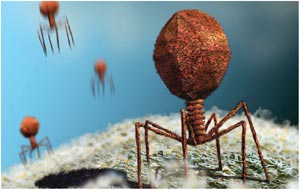
 By shuttling genes into and out of their hosts, viruses seem to be a major driving force in the evolution of higher organisms. By shuttling genes into and out of their hosts, viruses seem to be a major driving force in the evolution of higher organisms.
 Many viruses carry and use a long list of genes formerly thought to be useful only in cells, such as those needed for photosynthesis. Many viruses carry and use a long list of genes formerly thought to be useful only in cells, such as those needed for photosynthesis.
 Plant virologist James Van Etten has cultured an algae-infecting virus that carries a gene for hyaluronic acid, a molecule used by vertebrates as a joint lubricant, as well as viruses that make chitin, the protein used as a building block in insect exoskeletons. Plant virologist James Van Etten has cultured an algae-infecting virus that carries a gene for hyaluronic acid, a molecule used by vertebrates as a joint lubricant, as well as viruses that make chitin, the protein used as a building block in insect exoskeletons.
 Viral diversity is just way different from anything else. Every time we sequence it, most of everything we run into is unknown — microbiologist Forest Rohwer. Viral diversity is just way different from anything else. Every time we sequence it, most of everything we run into is unknown — microbiologist Forest Rohwer.
 In total there are now thought to be some 10^31 viral particles on the planet. One researcher estimates that these viral genes laid end to end would reach 250 million light years. In total there are now thought to be some 10^31 viral particles on the planet. One researcher estimates that these viral genes laid end to end would reach 250 million light years.
 Some researchers now believe that viruses have been instrumental in assembling the various molecular components that define the cell types associated with life's three domains — bacteria, archaea and eukaryotes. Some researchers now believe that viruses have been instrumental in assembling the various molecular components that define the cell types associated with life's three domains — bacteria, archaea and eukaryotes.
 Garry Hamilton, "The Gene Weavers" [text], 10.1038/441683a, p 683-685 v 441, Nature, 8 Jun 2006. Garry Hamilton, "The Gene Weavers" [text], 10.1038/441683a, p 683-685 v 441, Nature, 8 Jun 2006.
 Viruses and Other Gene Transfer Mechanisms is the main related CA webpage [ Viruses and Other Gene Transfer Mechanisms is the main related CA webpage [ What'sNEW about HGT What'sNEW about HGT  ]. ].
 20 June 2006 20 June 2006
Bats and horses are closely related, according to a genomic study using retroposon (L1) analysis. Trees of life based on genomics often look different from ones based on morphology, and they may even look different from each other depending on the genes compared and the method used. In this study three biologists in Japan compared the presence or absence of specific retroposon alleles to draw their tree. They decide that bats and horses are so closely related that they belong together in a newly identified clade called Pegasoferae, because Pegasus refers to the flying horse. By their method, bats, horses, dogs and cats look much more closely related than, for example, common shrews, tree shrews, and elephant shrews. The big differences between bats and horses exist because of incomplete lineage sorting ...followed by rapid divergence into the extant orders over an evolutionarily short period.
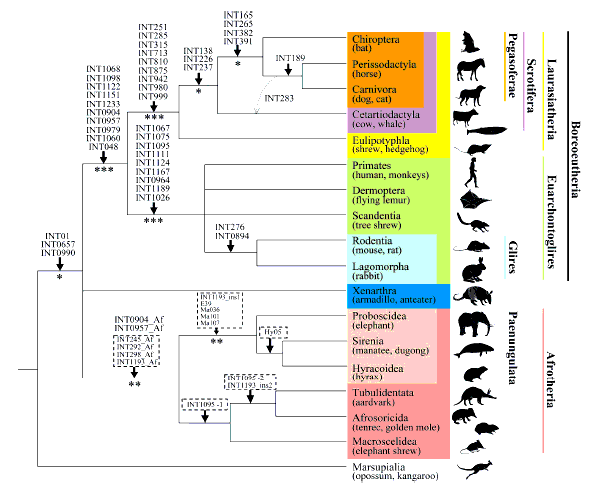
A mammalian phylogeny reconstructed by retroposon insertion analysis. Arrows denote insertions of retroposons into each lineage. © The National Academy of Sciences, 2006 |
We wonder, could a species lacking a given retroposon allele have simply lost it? This team thinks not, because to date, no mechanism has been described for the reversal of retroposon integration. And we think that dissimilar species which carry closely related retroposon alleles might have acquired them separately, independently. Again, this biology team thinks not. It is highly unlikely that the same type of retroposon would integrate into the same genomic locus independently in different lineages. But it is well known that whole introns, in whch the studied L1 sequences reside, can be precisely inserted; the process is sometimes called "homing." Could a software management capability like that also enable these retroposon sequences to home in on their destinations? Could the whole intron be a recent insertion? In sum, we think this study would have reached a more plausible conclusion if Nishihara et al. had recognized a bigger role for the gain and loss of introns, exons, and a variety of other large blocks of DNA in the course of evolution.
 Hidenori Nishihara, Masami Hasegawa, and Norihiro Okada, "Pegasoferae, an unexpected mammalian clade revealed by tracking ancient retroposon insertions" [abstract | Open Access PDF], 10.1073/pnas.0603797103, p 9929-9934 v 103, Proc. Natl. Acad. Sci. USA, 27 Jun (online 19 Jun) 2006. Hidenori Nishihara, Masami Hasegawa, and Norihiro Okada, "Pegasoferae, an unexpected mammalian clade revealed by tracking ancient retroposon insertions" [abstract | Open Access PDF], 10.1073/pnas.0603797103, p 9929-9934 v 103, Proc. Natl. Acad. Sci. USA, 27 Jun (online 19 Jun) 2006.
 Viruses and Other Gene Transfer Mechanisms is a related CA webpage [ Viruses and Other Gene Transfer Mechanisms is a related CA webpage [ What'sNEW about HGT What'sNEW about HGT  ]. ].
 Introns: A Mystery is a related CA webpage. Introns: A Mystery is a related CA webpage.
 The Tree of Life is a related CA webpage. The Tree of Life is a related CA webpage.
 Testing Darwinism versus Cosmic Ancestry is a related CA webpage. Testing Darwinism versus Cosmic Ancestry is a related CA webpage.
 15 June 2006 15 June 2006
Novel genes derived from noncoding DNA have been identified by biologists from the Universities of North Carolina and California, Davis. They begin their report by observing, Descriptions of recently evolved genes suggest several mechanisms of origin ...all of which involve recruitment of preexisting genes or genetic elements into new function. The importance of noncoding DNA in the origin of novel genes remains an open question. But no longer, apparently. Five genes in different fruitfly species seem to be derived from ancestral noncoding sequence. Furthermore, the genes initially underwent rapid adaptive evolution, whereafter about 9% of their nucleotides had non-synonymous, fixed substitutions. In darwinian theory, these noncoding sequences of 175 to 500 nucleotides acquired the essential programming for their new roles by luck. But if even only 25% of their nucleotides cannot be substituted, such luck is implausible. It is more likely, we suggest, that the programming was there all along.

 Mia T. Levine et al., "Novel genes derived from noncoding DNA in Drosophila melanogaster are frequently X-linked and exhibit testis-biased expression" [abstract], 10.1073/pnas.0509809103, p 9935-9939 v 103, Proc. Natl. Acad. Sci. USA, 27 Jun (online 15 Jun) 2006. Mia T. Levine et al., "Novel genes derived from noncoding DNA in Drosophila melanogaster are frequently X-linked and exhibit testis-biased expression" [abstract], 10.1073/pnas.0509809103, p 9935-9939 v 103, Proc. Natl. Acad. Sci. USA, 27 Jun (online 15 Jun) 2006.
 Viruses and Other Gene Transfer Mechanisms is a related CA webpage [ Viruses and Other Gene Transfer Mechanisms is a related CA webpage [ What'sNEW about HGT What'sNEW about HGT  ]. ].
 Conserved Non-Genic Sequences is a related CA webpage. Conserved Non-Genic Sequences is a related CA webpage.
 13 Sep 2010: Origins, evolution, and phenotypic impact of new genes cites the research discussed here. 13 Sep 2010: Origins, evolution, and phenotypic impact of new genes cites the research discussed here.
 ...De Novo Genes (2009) includes updates about this newly recognized phenomenon. ...De Novo Genes (2009) includes updates about this newly recognized phenomenon.
 13 June 2006 13 June 2006
Early life on Earth was already diverse. Australian and Canadian biologists conclude that the variety of stromatolites in Australia's Strelley Pool Chert was created by a rich marine ecosystem similar to ones that flourish on tidal platforms even now. But this formation can be reliably dated to 3.43 billion years ago, when such environments were new and rare. If life on Earth could have achieved this much diversity so quickly, could it have done the same on, say, Mars? People are asking.

 Abigail C. Allwood et al., "Stromatolite reef from the Early Archaean era of Australia" [abstract], 10.1038/nature04764, p 714-718 v 441, Nature, 8 Jun 2006. Abigail C. Allwood et al., "Stromatolite reef from the Early Archaean era of Australia" [abstract], 10.1038/nature04764, p 714-718 v 441, Nature, 8 Jun 2006.
 Stanley M. Awramik, "Respect for stromatolites" [text], 10.1038/441700a, p 700-701 v 441, Nature, 8 Jun 2006. Stanley M. Awramik, "Respect for stromatolites" [text], 10.1038/441700a, p 700-701 v 441, Nature, 8 Jun 2006.
 Erik Stokstad, "Ancient 'Reef' Stirs Debate Over Early Signs of Life in Australian Rocks" [summary], 10.1126/science.312.5779.1457, p 1457 v 312, Science, 9 Jun 2006. Erik Stokstad, "Ancient 'Reef' Stirs Debate Over Early Signs of Life in Australian Rocks" [summary], 10.1126/science.312.5779.1457, p 1457 v 312, Science, 9 Jun 2006.
 Complex ecosystems arrived early, by Michael Hopkin, News@Nature.com, 7 Jun 2006. Complex ecosystems arrived early, by Michael Hopkin, News@Nature.com, 7 Jun 2006.
 Early Life Was Abundant, TerraDaily, 12 Jun 2006. Early Life Was Abundant, TerraDaily, 12 Jun 2006.
 Life Before 3850 Million Years Ago? is a related CA webpage. Life Before 3850 Million Years Ago? is a related CA webpage.
 Thanks, Larry Klaes, Stan Franklin and Sean Underwood. Thanks, Larry Klaes, Stan Franklin and Sean Underwood.
 9 June 2006 9 June 2006
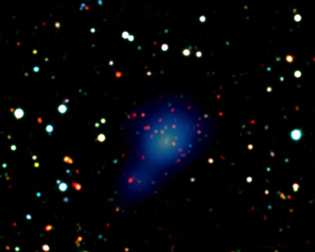
Faint red galaxies of the XMMXCS 2215-1738 galaxy cluster in the center, with the X-ray glow of hot intergalactic gas shown in blue. Credit: European Southern Observatory Imaging Survey; NOAO. |
Galaxies theoretically young look old. "Almost ten billion light years distant, galaxy cluster XMMXCS 2215-1738 is seen in what should be its earliest stages of formation. Yet this distant cluster appears to be full of old galaxies," discovery team member Adam Stanford noted with amazement.... The total mass of the cluster is enough to contain 500 trillion stars comparable in mass to our Sun. That's a surprising stellar mass for a galaxy cluster to have achieved at such an early era in the evolution of the universe, said Stanford, a researcher at the University of California, Davis, and at Lawrence Livermore National Laboratory.This result was announced at the 208th meeting of the American Astronomical Society in Calgary this week. This observation reminds us that the big bang theory still meets too many surprises for it to serve as the foundation for the rest of science. A recent article by Johns Hopkins astronomer Charles Bennett reinforces our opinion. He writes, We have not yet demonstrated that inflation actually happened, nor do we know the identity of the inflation field or the functional form of its effective potential.... We have no compelling model for the recent epoch of accelerated expansion."
 Maturity of Farthest Galaxy Cluster Surprises Astronomers, by Christine L. Kulyk, Space.com, 8 Jun 2006. Maturity of Farthest Galaxy Cluster Surprises Astronomers, by Christine L. Kulyk, Space.com, 8 Jun 2006.
 Charles L. Bennettt, "Cosmology from start to finish" [abstract], 10.1038/nature04803, p 1126-1131 v 440, Nature, 27 Apr 2006. Charles L. Bennettt, "Cosmology from start to finish" [abstract], 10.1038/nature04803, p 1126-1131 v 440, Nature, 27 Apr 2006.
 The End and the Big Bang is a related CA webpage. The End and the Big Bang is a related CA webpage.
 Thanks, Larry Klaes. Thanks, Larry Klaes.
 7 June 2006 7 June 2006
Blowflies were preadapted for the rapid evolution of insecticide resistance. An international team studying Lucilia cuprina and its sister species found that one amino acid replacement in esterase 3 confers resistance to diazinon, and two replacements confer malathion resistance. Blowflies already posessing malathion resistance can acquire diazinon resistance especially quickly. We note that this kind of evolution, often cited in support of darwinism, cannot be generalized to explain the invention of new features.
 C. J. Hartley et al., "Amplification of DNA from preserved specimens shows blowflies were preadapted for the rapid evolution of insecticide resistance" [abstract], 10.1073/pnas.0509590103, p 8757-8762 v 103, Proc. Natl. Acad. Sci. USA, 6 Jun (online 24 May) 2006. C. J. Hartley et al., "Amplification of DNA from preserved specimens shows blowflies were preadapted for the rapid evolution of insecticide resistance" [abstract], 10.1073/pnas.0509590103, p 8757-8762 v 103, Proc. Natl. Acad. Sci. USA, 6 Jun (online 24 May) 2006.
 NeoDarwinism... is a related CA webpage. NeoDarwinism... is a related CA webpage.
 1 June 2006 1 June 2006
Another Intelligent Design Theory is the way Skeptic Magazine categorizes panspermia. We wish Skeptic's science fiction writer would give references for the assertion that Fred Hoyle and Chandra Wickramasinge's calculations have been "since then refuted." And he ignores the strongest version of panspermia altogether. Is any publicity better than no publicity? We're not sure.

 The Other Intelligent Design Theories, by David Brin, v 12 n 2 Skeptic, 2006. The Other Intelligent Design Theories, by David Brin, v 12 n 2 Skeptic, 2006.
 Evolution vs Creationism is a related CA webpage. Evolution vs Creationism is a related CA webpage.
 ...A Third Alternative is a related CA webpage. ...A Third Alternative is a related CA webpage.
 Thanks, Ron McGhee. Thanks, Ron McGhee.
 17 May 2006 17 May 2006
A stupendously improbable accident is Robert Shapiro's characterization of the RNA World theory of the origin of life. To him it is more plausible that "life began within a mixture of simple organic molecules, multiplied through catalyzed reaction cycles and an external source of available energy." Shapiro is a biochemist at New York University. His new idea adds to the growing list of speculations about the origin of life. If we perceive any common thread among them, it is that they no longer attempt to deal with the software aspect of the problem.

 Robert Shapiro, "Small Molecule Interactions were Central to the Origin of Life" [abstract], doi:10.1086/506024, p 105-126 v 81, The Quarterly Review of Biology, Jun 2006. Robert Shapiro, "Small Molecule Interactions were Central to the Origin of Life" [abstract], doi:10.1086/506024, p 105-126 v 81, The Quarterly Review of Biology, Jun 2006.
 Small Molecule Interactions Were Central To The Origin Of Life, ScienceDaily.com, 16 May 2006. Small Molecule Interactions Were Central To The Origin Of Life, ScienceDaily.com, 16 May 2006.
 How Life Began: New Research Suggests Simple Approach, by Michael Schirber, Live Science, 9 Jun 2006. How Life Began: New Research Suggests Simple Approach, by Michael Schirber, Live Science, 9 Jun 2006.
 The RNA World is a related CA webpage with more new speculations listed among other developments under What'sNEW there. The RNA World is a related CA webpage with more new speculations listed among other developments under What'sNEW there.
 Thanks, Stan Franklin and Yahoo! Alerts. Thanks, Stan Franklin and Yahoo! Alerts.

 16 May 2006 16 May 2006
NASA's Astrobiology program has had high and (now) low periods. A four-part essay tells the story.
 Saving Astrobiology at NASA: Origins (Part 1), by Keith Cowing, SpaceRef.com, 15 May 2006. Saving Astrobiology at NASA: Origins (Part 1), by Keith Cowing, SpaceRef.com, 15 May 2006.
 Introduction: More than Panspermia is a related CA webpage. Introduction: More than Panspermia is a related CA webpage.
 Thanks, Larry Klaes. Thanks, Larry Klaes.
 11 May 2006 11 May 2006
It's clear now that you have many more genes in the viral world, so there are many interesting new enzymes to be found — Patrick Forterre, University of Paris-Sud, Orsay, France.
 Carl Zimmer, "Did DNA Come From Viruses?" [summary], 10.1126/science.312.5775.870, p 870-872 v 312, Science, 12 May 2006. Carl Zimmer, "Did DNA Come From Viruses?" [summary], 10.1126/science.312.5775.870, p 870-872 v 312, Science, 12 May 2006.
 Viruses and Other Gene Transfer Mechanisms is a related CA webpage [ Viruses and Other Gene Transfer Mechanisms is a related CA webpage [ What'sNEW about HGT What'sNEW about HGT  ]. ].
 9 May 2006 9 May 2006
 The structure of a bacterial enzyme that inserts mobile gene cassettes has been resolved by biochemists and geneticists in France. These ubiquitous gene cassettes provide antibiotic resistance, virulence factors and other traits to bacteria, and are among the major vehicles of bacterial gene exchange. How they are captured, inserted into their genomic arrays and subsequently regulated is worth knowing. The new research shows, among other things, that the enzyme's ability to recognize its target site depends on DNA bases that are "flipped out" of their normal double helix alignment. In another surprise, the enzyme complex (illustrated at right) installs the cassette as an unpaired (single) strand. In general, the process is quite complicated and the research raises several new questions.
The structure of a bacterial enzyme that inserts mobile gene cassettes has been resolved by biochemists and geneticists in France. These ubiquitous gene cassettes provide antibiotic resistance, virulence factors and other traits to bacteria, and are among the major vehicles of bacterial gene exchange. How they are captured, inserted into their genomic arrays and subsequently regulated is worth knowing. The new research shows, among other things, that the enzyme's ability to recognize its target site depends on DNA bases that are "flipped out" of their normal double helix alignment. In another surprise, the enzyme complex (illustrated at right) installs the cassette as an unpaired (single) strand. In general, the process is quite complicated and the research raises several new questions.
 Douglas MacDonald et al., "Structural basis for broad DNA-specificity in integron recombination" [abstract], 10.1038/nature04643, p 1157-1162 v 440, Nature, 27 Apr 2006. Douglas MacDonald et al., "Structural basis for broad DNA-specificity in integron recombination" [abstract], 10.1038/nature04643, p 1157-1162 v 440, Nature, 27 Apr 2006.
 Michael Chandler, "...Singled out for integration" [text], 10.1038/4401121a, p 1121-1122 v 440, Nature, 27 Apr 2006. Michael Chandler, "...Singled out for integration" [text], 10.1038/4401121a, p 1121-1122 v 440, Nature, 27 Apr 2006.
 Viruses and Other Gene Transfer Mechanisms is a related CA webpage [ Viruses and Other Gene Transfer Mechanisms is a related CA webpage [ What'sNEW about HGT What'sNEW about HGT  ]. ].
 9 May 2006 9 May 2006
 Organic matter in meteorites is extraterrestrial and ancient. Scientists at the Carnegie Institution's Department of Terrestrial Magnetism reached this conclusion after measuring the relative amounts of different isotopes of hydrogen and nitrogen associated with particles of organic matter in seven carbonaceous meteorites. Forty years ago, this finding would have been astonishing, because organic matter was thought to be only biotic or post-biotic. Now we know the stuff is out there. Now mainstream science welcomes it as pre-biotic, potential starting ingredients for life on Earth and other planets.
Organic matter in meteorites is extraterrestrial and ancient. Scientists at the Carnegie Institution's Department of Terrestrial Magnetism reached this conclusion after measuring the relative amounts of different isotopes of hydrogen and nitrogen associated with particles of organic matter in seven carbonaceous meteorites. Forty years ago, this finding would have been astonishing, because organic matter was thought to be only biotic or post-biotic. Now we know the stuff is out there. Now mainstream science welcomes it as pre-biotic, potential starting ingredients for life on Earth and other planets.
 Henner Busemann et al., "Interstellar Chemistry Recorded in Organic Matter from Primitive Meteorites" [abstract], 10.1126/science.1123878, p 727-730 v 312, Science, 5 May 2006. Henner Busemann et al., "Interstellar Chemistry Recorded in Organic Matter from Primitive Meteorites" [abstract], 10.1126/science.1123878, p 727-730 v 312, Science, 5 May 2006.
 Bernard Marty, "The Primordial Porridge" [summary], 10.1126/science.1125967, p 706-707 v 312, Science, 5 May 2006. Bernard Marty, "The Primordial Porridge" [summary], 10.1126/science.1125967, p 706-707 v 312, Science, 5 May 2006.
 Interstellar Organic Matter in Meteorites, by G. Jeffrey Taylor, Hawai'i Institute of Geophysics and Planetology,
posted on Planetary Science Research Discoveries (PSRD), 26 May 2006. Interstellar Organic Matter in Meteorites, by G. Jeffrey Taylor, Hawai'i Institute of Geophysics and Planetology,
posted on Planetary Science Research Discoveries (PSRD), 26 May 2006.
 Meteorites discovered to carry interstellar carbon, Carnegie Institution News Release, 4 May 2006. Meteorites discovered to carry interstellar carbon, Carnegie Institution News Release, 4 May 2006.
 Meteorites carry ancient carbon, by Helen Briggs, BBC News, 8 May 2006. Meteorites carry ancient carbon, by Helen Briggs, BBC News, 8 May 2006.
 Comets... is a related CA webpage. Comets... is a related CA webpage.
 Thanks, Stan Franklin and Sean Underwood. Thanks, Stan Franklin and Sean Underwood.
 4 May 2006 4 May 2006
A gene captured from a mobile element fused with another gene to make a new primate gene. Four biologists in Louisiana and Texas have used extensive sequence data to reconstruct the history of this gene, called SETMAR. Its assembly apparently occurred within a time window of 18 million years.
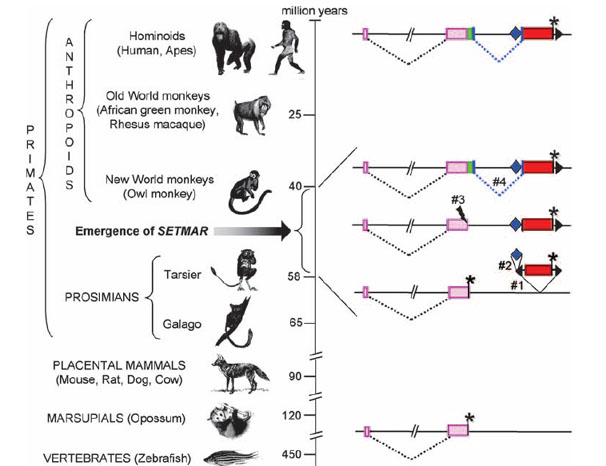 | | A simplified chronology of the divergence time of the species examined relative to hominoid primates (left) and the structure of the SETMAR locus (right) are shown. Starting at the bottom, pink boxes represent the two SET exons, which are separated by a single long intron (interrupted black line) and form a "SET-only" gene whose structure is conserved in all nonanthropoid species examined and terminated with a stop codon (*) located at an homologous position (except in cow...). The Hsmar1 transposon (#1) is inserted in the primate lineage, after the split between tarsier and anthropoids, but before the divergence of extant anthropoid lineages. The transposon is shown here with its TIRs (black triangles) and transposase coding sequence (red box). The secondary AluSx insertion within the TIR of Hsmar1 (#2) is represented as a blue diamond. The position of the deletion removing the stop codon of the "SET-only" gene (#3) is indicated by a black lightning bolt. The de novo conversion from noncoding to exonic sequence is shown in green, and a bent dashed blue line represents the creation of the second intron (#4), whose two ends are splice sites, shown as short thick vertical blue lines. © The National Academy of Sciences |
The function of the gene is not yet known, but evidently the protein it encodes, 671 amino acids in length, is broadly expressed. Also, the portion of it derived from a mobile element appears to be under strong purifying selection. And this portion binds to a 19-base-pair DNA binding site of which the human genome contains more than 1500 perfect or near-perfect copies. This ubiquity suggests to the researchers that there is "a previously uncharacterized mechanism by which the circuitry underlying complex regulatory networks may be rapidly established." That mechanism could be part of the software management system that eukaryotic genomes would need, if they can acquire new programs as proposed in cosmic ancestry. We believe that the core finding of this study, in which exon-sized strands of DNA have been relocated and joined to make a new gene, supports the case for cosmic ancestry's mechanism.
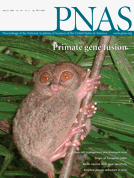
 Richard Cordaux et al., "Birth of a chimeric primate gene by capture of the transposase gene from a mobile element" [abstract], 10.1073/pnas.0601161103, p 8101-8106 v 103, Proc. Natl. Acad. Sci. USA, 23 May (online 3 May) 2006. Richard Cordaux et al., "Birth of a chimeric primate gene by capture of the transposase gene from a mobile element" [abstract], 10.1073/pnas.0601161103, p 8101-8106 v 103, Proc. Natl. Acad. Sci. USA, 23 May (online 3 May) 2006.
 I. King Jordan, "Evolutionary tinkering with transposable elements" [extract], 10.1073/pnas.0602656103, p 7941-7942 v 103, Proc. Natl. Acad. Sci. USA, 23 May (online 15 May) 2006. I. King Jordan, "Evolutionary tinkering with transposable elements" [extract], 10.1073/pnas.0602656103, p 7941-7942 v 103, Proc. Natl. Acad. Sci. USA, 23 May (online 15 May) 2006.
 Viruses and Other Gene Transfer Mechanisms is a related CA webpage [ Viruses and Other Gene Transfer Mechanisms is a related CA webpage [ What'sNEW about HGT What'sNEW about HGT  ]. ].
 Introns... is a related CA webpage. Introns... is a related CA webpage.
 Human Genome Search... is a related CA webpage. Human Genome Search... is a related CA webpage.
 New genetic programs in Darwinism and strong panspermia is a related CA webpage. New genetic programs in Darwinism and strong panspermia is a related CA webpage.
 Thanks, Mark Batzer, coauthor of the study. Thanks, Mark Batzer, coauthor of the study.
 3 May 2006 3 May 2006
Genes undergo rapid mutation and selection immediately after transfer, according to a pair of biologists studying bacteria at McMaster University. First they note that the rate of gene insertion and deletion is usually underestimated by the standard techniques, and is greatest "at the tips of phylogeny." Using a comprehensive method of analysis, they write:

- ...During the evolutionary time period required for one substitution per site, an entire gene could possibly have been inserted/deleted about five times in the [fastest evolving] group.
- If this is an evolutionarily stable situation, then most of the laterally transferred genes must be lost shortly after their insertion during evolution.
- ...Genes that have been recently transferred into these hosts have a higher percentage of nonsynonymous substitutions. Together, the recently transferred genes not only have faster evolutionary change but also have higher Ka/Ks ratios.
- ...Gene movement in bacteria should be considered as a result of the dynamic process of passive uptake and of quick selection on those genes appropriate for the current bacterial niche or their rapid elimination.
All of this makes good sense to us, if the evolution of new features and capabilities depends on acquired genetic programs. Acquired genes would undergo immediate testing for usefulness and compatibility with the host. Many would be quickly rejected, but, after enough rounds of exploratory and optimizing mutations, some would remain. Eventually the clues that they were originally acquired by transfer may become lost. Signs of the same general process are also seen among eukaryotes.
 Weilong Hao and G. Brian Golding, "The fate of laterally transferred genes: Life in the fast lane to adaptation or death" [abstract | Open Acess PDF], 10.1101/gr.4746406, p 636-643 v 16, Genome Research, May 2006. Weilong Hao and G. Brian Golding, "The fate of laterally transferred genes: Life in the fast lane to adaptation or death" [abstract | Open Acess PDF], 10.1101/gr.4746406, p 636-643 v 16, Genome Research, May 2006.
 More Gene Movements Tend to Occur at the Tips of Phylogeny: an Inference of Maximum Likelihood, Hao and Golding, 24 May - 4 Jun 2005. More Gene Movements Tend to Occur at the Tips of Phylogeny: an Inference of Maximum Likelihood, Hao and Golding, 24 May - 4 Jun 2005.
 Viruses and Other Gene Transfer Mechanisms is the main related CA webpage [ Viruses and Other Gene Transfer Mechanisms is the main related CA webpage [ What'sNEW about HGT What'sNEW about HGT  ]. ].
 2 May 2006 2 May 2006
Once one planet comes down with life, they all get it. — Jeff Moore, NASA, Ames Research Center
 Did Earth seed life elsewhere in the Solar System? by Mark Peplow, NatureNews, doi:10.1038/news060313-18, online 17 Mar 2006. Did Earth seed life elsewhere in the Solar System? by Mark Peplow, NatureNews, doi:10.1038/news060313-18, online 17 Mar 2006.
 Introduction... is a related CA webpage. Introduction... is a related CA webpage.
 Thanks, Yahoo! Alerts. Thanks, Yahoo! Alerts.
|
 Conference on Cosmic Dust and Panspermia — Chandra Wickramasinghe and Fred Hoyle have been pioneers of the modern version of cometary panspermia. From being a fringe theory derided 30 years ago, panspermia is fast gaining acceptance in mainstream astrobiology. The conference to mark the completion of Chandra's 33 year long tenure of a professorship in Cardiff aims to bring together research workers in diverse areas of science that appear to have a bearing on unravelling our cosmic ancestry, and in one way or another supports the concept of panspermia. The venue of the conference at a leading UK university in an attractive city which is Europe's youngest capital city is an added bonus to prospective participants. Since the number of places is limited, early registration is recommended.
Conference on Cosmic Dust and Panspermia — Chandra Wickramasinghe and Fred Hoyle have been pioneers of the modern version of cometary panspermia. From being a fringe theory derided 30 years ago, panspermia is fast gaining acceptance in mainstream astrobiology. The conference to mark the completion of Chandra's 33 year long tenure of a professorship in Cardiff aims to bring together research workers in diverse areas of science that appear to have a bearing on unravelling our cosmic ancestry, and in one way or another supports the concept of panspermia. The venue of the conference at a leading UK university in an attractive city which is Europe's youngest capital city is an added bonus to prospective participants. Since the number of places is limited, early registration is recommended.






 The structure of a bacterial enzyme that inserts mobile gene cassettes has been resolved by biochemists and geneticists in France. These ubiquitous gene cassettes provide antibiotic resistance, virulence factors and other traits to bacteria, and are among the major vehicles of bacterial gene exchange. How they are captured, inserted into their genomic arrays and subsequently regulated is worth knowing. The new research shows, among other things, that the enzyme's ability to recognize its target site depends on DNA bases that are "flipped out" of their normal double helix alignment. In another surprise, the enzyme complex (illustrated at right) installs the cassette as an unpaired (single) strand. In general, the process is quite complicated and the research raises several new questions.
The structure of a bacterial enzyme that inserts mobile gene cassettes has been resolved by biochemists and geneticists in France. These ubiquitous gene cassettes provide antibiotic resistance, virulence factors and other traits to bacteria, and are among the major vehicles of bacterial gene exchange. How they are captured, inserted into their genomic arrays and subsequently regulated is worth knowing. The new research shows, among other things, that the enzyme's ability to recognize its target site depends on DNA bases that are "flipped out" of their normal double helix alignment. In another surprise, the enzyme complex (illustrated at right) installs the cassette as an unpaired (single) strand. In general, the process is quite complicated and the research raises several new questions. Organic matter in meteorites is extraterrestrial and ancient. Scientists at the Carnegie Institution's Department of Terrestrial Magnetism reached this conclusion after measuring the relative amounts of different isotopes of hydrogen and nitrogen associated with particles of organic matter in seven carbonaceous meteorites. Forty years ago, this finding would have been astonishing, because organic matter was thought to be only biotic or post-biotic. Now we know the stuff is out there. Now mainstream science welcomes it as pre-biotic, potential starting ingredients for life on Earth and other planets.
Organic matter in meteorites is extraterrestrial and ancient. Scientists at the Carnegie Institution's Department of Terrestrial Magnetism reached this conclusion after measuring the relative amounts of different isotopes of hydrogen and nitrogen associated with particles of organic matter in seven carbonaceous meteorites. Forty years ago, this finding would have been astonishing, because organic matter was thought to be only biotic or post-biotic. Now we know the stuff is out there. Now mainstream science welcomes it as pre-biotic, potential starting ingredients for life on Earth and other planets.
